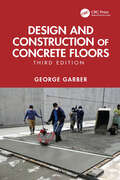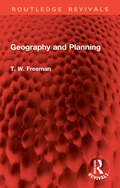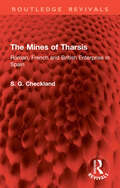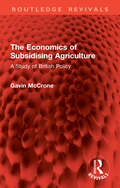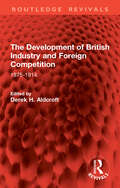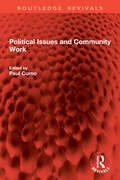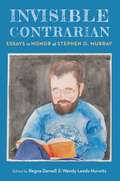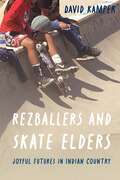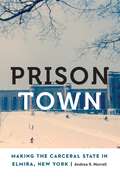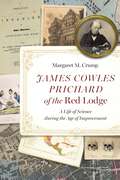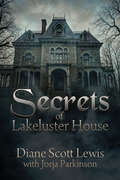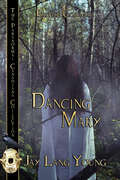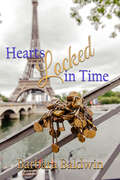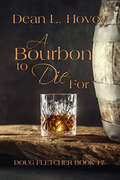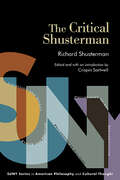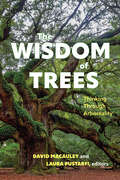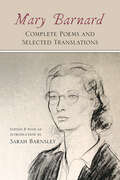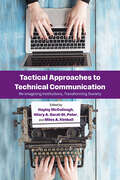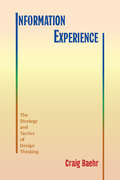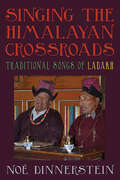- Table View
- List View
Beyond Emancipation: Maroon Freedoms in US Literature, 1850–1862 (SUNY series in Multiethnic Literatures)
by Sean GerrityExplores how African American literary representations of maroons in the decade leading up to the Civil War complicate conventional narratives and geographies of slavery and freedom in the United States.Beyond Emancipation revisits classic works of nineteenth-century American literature, especially by Black writers, to uncover a hidden history of maroons-enslaved people who ran away but remained hidden in the South. Sean Gerrity argues that literary depictions of "small acts" of marronage reveal an expanded sense of what freedom might look like and where and when it might occur. While taking care not to romanticize historical realities, Gerrity vividly shows how works by Frederick Douglass, Harriet Jacobs, and Martin Delany gesture toward possibilities for Black freedom-making beyond legal emancipation, liberalism, and the white abolitionist literary tradition passed down from Harriet Beecher Stowe. While Beyond Emancipation focuses on texts produced during the brief period between the Fugitive Slave Act of 1850 and the Civil War, the book's range of reference and implications are broad, unsettling still dominant ideas and engaging pressing questions in literary criticism, history, geography, and Black studies.
Design and Construction of Concrete Floors
by George GarberDesign and Construction of Concrete Floors recognizes that a good floor must do far more than support its intended loads. This thoroughly updated third edition provides further insight into polished concrete, limestone cement, and jointless floors for an international audience of structural engineers, architects, and building developers. This book discusses structural design, crack control, flatness, wear resistance, slip resistance, and suitability for floor coverings.This book provides detail on different concrete floor types, including ground-supported concrete floors; suspended concrete floors; office and residential floors; institutional floors, including those in hospitals and libraries; industrial floors, including those that support robotic equipment; floors over contaminated soil; superflat floors; and polished concrete. In addition, this book expands on designing floors for sustainability and reduced carbon footprint.
Geography and Planning (Routledge Revivals)
by T. W. FreemanOriginally published in 1958, as a third edition in 1967, and revised fourth edition in 1974, this established text discusses the challenges of physical and regional geography to planners and studies the relationship between geography, economics and change in both urban and rural settings. It reflects the increasing concern in the late 20th Century with the environment and quality of life. The author argues strongly that there must be three related orders of planning: national, regional and local, because the building of a better Britain depends on work done in detail at street and field level, with the geographical basis of planning being clear in such work. At a time when the UK government is considering an overhaul of the planning system in order to meet house-building targets and climate change is having a real impact on land use, many of the issues raised in this book are as relevant now as they were when it was first published.
The Mines of Tharsis: Roman, French and British Enterprise in Spain (Routledge Revivals)
by S. G. ChecklandOriginally published in 1967, this book discusses the attempt in ancient and modern times to exploit one of the great mineral areas of Europe. The extraordinary Roman workings at Tharsis in south-west Spain were reopened in Queen Victoria’s reign, with the copper and sulphur they contained being much sought after. The mines at Tharsis played an important part in the formation of the United Alkali Company and in the discovery of the revolutionary MacArthur-Forrest gold extraction process, so critical for South Africa. At the time of its publication, no comparable study of a major mining enterprise existed. The author successfully synthesised the scientific and technical factors with the economic, social and political ones. The continuous struggle for both mining efficiency and markets is discussed, as are the difficulties caused by the Great Depression and the Spanish Civil War. The book will appeal to historians, students of business history and marketing, applied science and technology as well as those interested in the problems of foreign enterprise in what was (at the time) a relatively undeveloped country.
The Economics of Subsidising Agriculture: A Study of British Policy (Routledge Revivals)
by Gavin McCroneOriginally published in 1962, this book was a study of British agricultural policy since the Second World War – during a period which saw the adoption of a comprehensive system of agricultural support which stood in marked contrast to the free trade policy adhered to previously. The policy of support brought a substantial increase in the output of British agriculture, but it imposed a heavy burden on the taxpayer and was the subject of much controversy. The author considers the economic issues involved with this policy and compares the role of agriculture in Britain with the part it played at the time in other countries. The book analyses the main sources of Britain’s food supply in the second half of the 20th century and examines the effect of the European Common Market. The British system of support is contrasted with that used in other European countries.
The Development of British Industry and Foreign Competition: 1875-1914 (Routledge Revivals)
by Derek H. AldcroftOriginally published in 1968 this important work covers a crucial period in Britain’s economic history. In the three or four decades before the First World War British industry was subject to increasing foreign competition particularly from America and Germany. This book reviews the main developments in 10 industries, paying particular attention to the way in which they were affected by foreign competition, and the measures taken to combat it. Each case is analysed in terms of how progressive the British industrialists were and to what extent they were willing to innovate or alter their methods to meet the new conditions. In cases where a lack of enterprise was clear, the contributors have tried to determine what the major factors were which governed the pace of innovation. The book will be of interest to economists, economic historians and sociologists as well as those interested in industrial innovation.
Political Issues and Community Work (Routledge Revivals)
by Paul CurnoOriginally published in 1978 this book was compiled with practitioners in mind. It clarifies the implications of significant political theories and issues of the 20th Century which affected their work. Drawing on case studies from their own experience, the contributors underline the political variables facing the community worker, whatever the context. Examples are from the local neighbourhood, from inside and outside the local authority, and – dramatically illustrating the ideological, practical and political dilemmas faced in some form by most community groups – from a picture of community action in Northern Ireland. The final section considers two growing strands in community work – the importance attached to developing knowledge and technical competence, and the increasing emphasis being given to making alliances with other relevant groups and organisations.
Building in the British Economy Between the Wars (Routledge Revivals)
by Derek H. Aldcroft Harry W RichardsonOriginally published in 1968 this important work covers a crucial period in Britain’s economic history. In the three or four decades before the First World War British industry was subject to increasing foreign competition particularly from America and Germany. This book reviews the main developments in 10 industries, paying particular attention to the way in which they were affected by foreign competition, and the measures taken to combat it. Each case is analysed in terms of how progressive the British industrialists were and to what extent they were willing to innovate or alter their methods to meet the new conditions. In cases where a lack of enterprise was clear, the contributors have tried to determine what the major factors were which governed the pace of innovation. The book will be of interest to economists, economic historians and sociologists as well as those interested in industrial innovation.
New Dimensions of World Politics (Routledge Revivals)
by Andrew Linklater Geoffrey L. GoodwinNew Dimensions of World Politics (1975) examines the changes to world politics as bankers, industrialists and scientists have taken more influence over world affairs from diplomats and soldiers. The content of ‘high politics’ has expanded from the security realm to include not only monetary, trade and aid matters but also the management of natural resources. There are more state actors, and more multinational corporations vying for the lead in influence.
90 Seconds to Midnight: A Hiroshima Survivor's Nuclear Odyssey
by Charlotte DeCroes Jacobs90 Seconds to Midnight tells the gripping and thought-provoking story of Setsuko Nakamura Thurlow, a thirteen-year-old girl living in Hiroshima in 1945, when the city was annihilated by an atomic bomb. Struggling with grief and anger, Thurlow set out to warn the world about the horrors of a nuclear attack in a crusade that has lasted seven decades. In 2015 Thurlow sparked a rallying cry for activists when she proclaimed at the United Nations, &“Humanity and nuclear weapons cannot coexist.&” With that, she shifted the global discussion from nuclear deterrence to humanitarian consequences, the key in crafting the landmark Treaty on the Prohibition of Nuclear Weapons. Regarded as the conscience of the antinuclear movement, Thurlow accepted the 2017 Nobel Peace Prize on behalf of the International Campaign to Abolish Nuclear Weapons. With the fate of humanity at stake and with the resolve of her samurai ancestors, Thurlow challenged leaders of the nuclear-armed states. On January 22, 2021, the Treaty on the Prohibition of Nuclear Weapons went into effect, banning nuclear weapons under international law. Critical historical events need a personal narrative, and Thurlow is such a storyteller for Hiroshima. 90 Seconds to Midnight recounts Thurlow&’s ascent from the netherworld where she saw, heard, and smelled death and her relentless efforts to protect the world from an unspeakable fate. Knowing she would have to live with those nightmares, Thurlow turned them into a force to impel people across the globe to learn from Hiroshima, to admit that yes, it could happen again—and then to take action.
Invisible Contrarian: Essays in Honor of Stephen O. Murray (Critical Studies in the History of Anthropology)
by Regna Darnell Wendy Leeds-HurwitzIn Invisible Contrarian Regna Darnell and Wendy Leeds-Hurwitz have assembled scholars to memorialize and celebrate the prescient vision and interdisciplinary contributions of the late Stephen O. Murray (1950–2019), who did pioneering research in ethnolinguistics and anthropology of gender and homosexuality. His socially relevant work continues to provide a cogent example of an emergent, forward-looking anthropology for the twenty-first century. Murray&’s wide-ranging work included linguistics, regional ethnography in Latin America and Asia, activism, history of anthropology in relation to social sciences, and migration studies. Along with a complete list of his publications, Invisible Contrarian highlights Murray&’s methodological innovations and includes key writings that remain little known, since he never pursued a tenured research position. Murray&’s significant, prolific contributions deserve not only to be reexamined but to be shared with contemporary and future audiences. Ideal both as a primer for those who have not yet read Murray&’s work and as an in-depth resource for those already familiar with him, this volume demonstrates the wide-ranging accomplishments of a man who modeled how to be an independent scholar outside an academic position.
Rezballers and Skate Elders: Joyful Futures in Indian Country
by David KamperEthnographer and American Indian studies scholar David Kamper examines how Indigenous youth and adults are making basketball and skateboarding meaningful to their communities by sustaining the transmission of intergenerational knowledge and combatting intergenerational trauma. Kamper looks at how the events and tournaments built around rezball are similar to powwows in how they bring people together across localized communities and generations and he coins the phrase &“skate elders&” for those who use the social nature of skateboarding to build community and mentorships. Through a broad picture of North America, Kamper demonstrates how Native peoples have long indigenized cultural practices and material culture to assert Native sovereignty, creating joy and hope in the process. In Rezballers and Skate Elders Kamper considers how Native expressions of basketball and skateboarding show continuities with the historical transformation of practices that originated outside Indian Country to make them meaningful in Native life.
Planting Seeds of the Divine: Torah Commentaries to Cultivate Your Spiritual Practice
by Yiscah SmithExperiencing deep personal fulfillment, happiness, and sustenance comes from feeling connected to our authentic selves, which involves building an ongoing relationship with the Divine Presence within us, says author Yiscah Smith. Quite organically, then, we may begin sensing the Divine in our interactions with other people. This is because, for each of us, &“our essence, as a creation by God, is God.&”Planting Seeds of the Divine elucidates how Judaism&’s sacred texts can provide the foundation for the &“end destination&” of experiencing intimate encounters with the Divine Presence within—the God-consciousness that so many of us find elusive. Imagining ourselves as spiritual gardeners, we can cultivate our unique gardens with seeds centered on middot (emotional dispositions, character traits, spiritual sensitivities). Each seed corresponds to an aspirational Torah commentary, consisting of a selected Torah verse linked to one of the middot, a summary of the biblical text preceding the verse, classical commentaries, teachings of Hasidic and Neo-Hasidic masters and the author, and step-by-step experiential practices to help us internalize the middot and encounter the Divine. Each seed contributes to the garden&’s beauty—the beauty of the self in God-consciousness—which hopefully blossoms into a magnificent garden of the soul.
Prison Town: Making the Carceral State in Elmira, New York (Anthropology of Contemporary North America)
by Andrea R. MorrellElmira, a town of about twenty-six thousand people in central New York, is in some ways a typical town—with quiet, tree-lined residential streets, an art museum, local coffee shops, and a small college. The city, however, is best known as home to Elmira Correctional Facility and, until its closure in March 2022, the Southport Correctional Facility. Hundreds of locals have worked at the prisons, the town plays host to visitors of the incarcerated, and local medical institutions provide treatment to prisoners. The prisons and Elmira are inseparable. In Prison Town Andrea R. Morrell illustrates the converging and shifting fault lines of race and class through a portrait of a prison town undergoing deindustrialization as it chooses the path of prison expansion. In this ethnography, Morrell highlights the contradictions of prison work as work that allows a middle-class salary and lifestyle but trades in other forms of stigma. Guards, prisoners, prisoners&’ families, and meager amounts of money and care work travel through spaces of free and unfree via the porous borders between prison and town. As Morrell captures the rapid expansion of the carceral state into upstate New York from the perspective of a small city with two prisons, she demonstrates how the prison system&’s racialized, gendered, and classed dispossession has crossed its own porous borders into the city of Elmira.
James Cowles Prichard of the Red Lodge: A Life of Science during the Age of Improvement (Critical Studies in the History of Anthropology)
by Margaret M. CrumpMargaret M. Crump offers the first thorough biography of British scientist and physician James Cowles Prichard (1786–1848), an intellectual giant in the developing human sciences, a pioneering psychiatric theorist, and Europe&’s leading anthropologist during the first half of the nineteenth century.
Secrets of Lakeluster House
by Diane Scott Lewis Jorja ParkinsonSage, at fourteen,growsup inturmoil inNahant, Massachusetts.Her changing body,herparents’rocky marriage.When her cousin Patrickvisitsfor thesummer,his parents’divorce has given him a reckless anger. He insists they explore the creepy mansion inthe woods.Nate,Sage’s younger brother,is reluctant to approach themanor where abeloved teacherwas found hangedmonths earlier.The children’s great-greatgrandmother worked at Lakeluster Housein a previous centuryand was undersuspicion of shooting another servant
Dancing Mary: The Paranormal Canadiana Collection (The Paranormal Canadiana Collection)
by Jay Lang-YoungIn the shadows of British Columbia’s Comox Valley, a tragic history refuses to rest. Based on chilling true events, Dancing Mary unearths the long-buried story of a young K’ómoks First Nation woman—named Mary by early settlers—who was betrayed and murdered by the very man she once trusted. Her spirit, said to appear as a shimmering blue orb, haunted the area for decades. The last vivid encounter occurred in 1914, when a soldier cycling down Comox Road rode through the ghostly light and described another worldly cold that he would never forget. From that moment on, the legend of “Dancing Mary” was born—named for the spectral sway of her ghostly presence.
Hearts Locked in Time
by Barbara BaldwinJordanBarrister loves her grandfather, her unique candle creations, and the life she’s built in present day Chicago. Her latest hobby obsessions, however, are love locks from a section of grille purchased at auction from Paris’ famed Pont des Arts pedestrian bridge. She’s determined to createa lasting tribute to those who put a lock on the bridge to safeguard their love. While a lock is normally used to keep something in, one particular lock accidentally opens a time portal and Jordan finds herself in 1926 Chicago. In the beginning all Jordan wants is to return to her own ime, and she believes the now missing lock holds the key, but she needs Henry’s helpt o navigate this unknown period of history. By the time they discover the lock’s whereabouts and are in pursuit, she has fallen in love and wonders if she really wants to return to the present. How can she let go of the man who holds the key to her heart? When disaster strikes, they will need to usewhat they discovered to find the magic of the love lock that will keep their hearts together.
A Bourbon to Die For: Doug Fletcher Book 17 (Doug Fletcher)
by Dean L. HoveyThe icon of a Scottish distilling family has opened a bourbon distillery near Elizabethtown, Kentucky. Only days before his much anticipated first release, he’s found dead inside Lincoln’s Birthplace National Historic Site. Becauseof the victim’s notoriety, Doug and Jill Fletcher are asked to assist the local policewith the investigation. The mystery becomes even more intriguing when a homelessman seems to know more about the victim and his business than the police.
The Critical Shusterman (SUNY series in American Philosophy and Cultural Thought)
by Richard ShustermanCollecting sixteen key texts on a broad range of key philosophical topics enables readers to perceive the scope of Shusterman's philosophy and appreciate its systematic aspects.Richard Shusterman is one of today's foremost philosophers. His influential and widely translated work is distinctive for its originality and its integration of multiple philosophical perspectives (analytic philosophy, phenomenology, hermeneutics, critical theory, and East Asian thought) to create a new transcultural pragmatist vision. Although most famous for his groundbreaking writings in aesthetics, somatic philosophy, and philosophy as an art of living, these texts are integrally connected with Shusterman's vital views on ontology, epistemology, and philosophy of mind, ethics, and politics. Collecting sixteen key texts on this broad range of topics, The Critical Shusterman enables readers to perceive the scope of Shusterman's philosophy and appreciate its systematic aspects. Editor Crispin Sartwell's superb introduction highlights those aspects in assessing Shusterman's thought in the context of contemporary philosophy while suggesting ways that Shusterman's project could be developed in the future.
The Wisdom of Trees: Thinking Through Arboreality (SUNY series in Environmental Philosophy and Ethics)
by David Macauley; Laura PustarfiPioneering essays that reveal the significance of new interdisciplinary understandings of trees and forests, especially in terms of their philosophical and ecological dimensions and their importance for addressing the climate emergency.This is the first book to apply philosophical thinking to trees. Through a series of sixteen diverse essays by leading scholars and writers, along with an in-depth introduction to the key issues and ideas, it examines the new and emerging understanding of trees in science and society. Contributors show how these developments encourage a revisioning of philosophical thought and a more sustainable relationship with trees and forests-a reconceptualization with important ecological and social implications for responding to deforestation, the loss of biodiversity, and the climate emergency. The interdisciplinary contributions in this collection investigate the many interconnected dimensions of arboreality, focusing on subjects related to time, mind, truth, memory, being, beauty, goodness, silence, wisdom, personhood, and death. The volume engages in a conversation about why trees matter, how they can best be protected, our obligations to them, and even what or who they are. Most of the chapters are informed by natural history or ecological science and many share a particular emphasis on continental philosophy and the environmental humanities.
Mary Barnard: Complete Poems and Selected Translations
by Mary BarnardThe most comprehensive collection of writing by award-winning US poet, renowned translator of Sappho, and trailblazing archivist Mary Barnard.Born in the Pacific Northwest, Mary Barnard (1909–2001) struck up correspondence with Ezra Pound in 1933, won Poetry magazine's prestigious Levinson Award in 1935, and moved to New York City the following year. There she met Marianne Moore and William Carlos Williams, who proclaimed her writing emblematic of "what we have been about all these years." This fully annotated volume makes available Barnard's complete poems for the first time, along with a robust selection of her translations and prose. Most well-known for her bestselling Sappho and her influential role as the inaugural poetry curator at the University at Buffalo, Barnard was a "second-wave" modernist and "late" Imagist whose regionally grounded writing also anticipated later eco-poetry. The volume's editor, Barnard scholar and biographer Sarah Barnsley, situates Barnard's work within these broader literary and cultural currents. Previously unpublished poems appear alongside Barnard's essays on her creative practice and friendships, illuminating the career, oeuvre, and ethos of this pivotal yet still underappreciated twentieth-century figure. With a foreword by Mary de Rachewiltz (author of Ezra Pound, Father and Teacher) and afterword by Barnard's literary executor Elizabeth J. Bell, Mary Barnard is essential reading for poets, scholars, and translators.
Tactical Approaches to Technical Communication: Reimagining Institutions, Transforming Society (SUNY series, Studies in Technical Communication)
by Hayley McCullough; Hilary A. Sarat-St. Peter; Miles A. KimballDelves into how individuals tactically exist within communicative systems, carving out spaces for themselves in places they don't necessarily fit.In 1984, Michel de Certeau described the terms "strategies" as how institutions communicate their wants/demands/desires and "tactics" as how individuals navigate these potentially hostile, unwelcoming systems. A little over two decades later, Miles A. Kimball solidified the idea of tactical technical communication, laying the foundations for a new area of inquiry and scholarship. Today, many academics and researchers have imbued the concept of tactical technical communication with their own ideas and perspectives. This essay collection spotlights a meaningful diversity of tactical technical communication scholarship, exploring topics like the feminist punk magazine BIKINI KILL, the phenomenon of copwatching, the usage of fictional narratives in technical writing courses, and the challenges of LBGTQ+ visibility in local libraries. In many ways, the contributors are partaking in their own forms of tactical communication as they carve out spaces for themselves and their ideas within the academic discourse.
Information Experience: The Strategy and Tactics of Design Thinking (SUNY series, Studies in Technical Communication)
by Craig BaehrInformation isn't simply read or used, rather it creates a holistic experience for users.Information Experience provides a usable framework for developing information products and design thinking practices for a wide range of projects, including application development, content creation, instructional materials, and user experience design. Whether content is created by human, machine, or artificial intelligence, memorable information experiences begin with the user, encompassing how user research, content development strategies, and design tactics fit together in creating engaging information experiences and products. The book provides an in-depth discussion of the components of information experience, including user perception, cognition, environment design, strategic branding, and tactical design. Collectively, these elements provide a foundation for understanding how information products function on a level beyond utility, as holistic and immersive experiences for users.
Singing the Himalayan Crossroads: Traditional Songs of Ladakh
by Noé DinnersteinIntroduces the traditional songs of Himalayan Ladakh through their history, ethnology, poetry, and Tibetan Buddhism beliefs.Singing the Himalayan Crossroads places the traditional song repertoires of the former Himalayan kingdom of Ladakh in both their historical and modern contexts. Although scholarly, it is aimed at a broad general audience, including people interested in ethnomusicology, Tibet, Buddhism, the Silk Road, or the music and cultures of Central and South Asia.While many songs contain texts that evoke Buddhist meditative visualization practices, at the same time, Muslims, both Sunni and Shia, were prominent in Silk Road caravans that enriched the Buddhist aristocracy. Songs from these Muslim traders often mention important religious sites in Kashmir while having nostalgia for the sights of the Ladakhi capital, Leh. Interweaving these themes, author Noé Dinnerstein mixes a relaxed, conversational narrative with the music and poetry of the songs to evoke the crossroads of High Asia.A separate anthology of recordings is available online.

